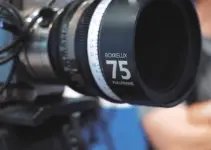Fancy, fun transitions are common online and can quickly become boring and overused. Not saying you should never them, but you should be cautious about when and how you use them.
Parker Walbeck from Full Time Filmmaker is hoping to help by presenting the 12 most-common cuts and transitions that are used on Hollywood films. They use them for a reason, so pay attention.
1. The Hard Cut
Nothing to this one. It’s a simple, basic cut. One frame you are on one shot, the next you are on another. This is a go-to cut since it doesn’t distract from the content. You’ll see this when scenes cut from wide to close-ups or when multiple people are talking it will cut back and forth.
One thing to note is the 30° rule, which says that when you make a cut you’ll want the angle to be at least 30° different. Otherwise, it can be very jarring. Same applies from going from a medium/wide to a close-up, and vice versa. If the change isn’t enough it just feels wrong to the viewer. That actually leads perfectly into…
2. The Jump Cut
This is when you don’t have a dramatic change between your perspective for a hard cut and it can be jarring. While you want to avoid unintentional jump cuts, they can actually be used to help show time passing or to make things move faster.
It’s very helpful for shortening a clip that feels long. You can also cheat things with jump cuts if you are using a tripod since it minimizes the overall impact of the cut.
3. The “L” Cut
Another simple cut for video, the L cut actually refers to the audio. Simply put, the L cut is when the audio from your first clip continues on after you visually cut to the second clip.
If you look at the timeline the first clip and its audio form the shape of an L. Makes sense. It can help smooth over a transition and a good example is cutting away from someone to a reaction shot while they are still talking.
4. The “J” Cut
Opposite to the L cut, the J cut is for when the audio from the second clip starts before the video. Again, the name comes from the footage looking like a “J” on the timeline.
It helps get your audience ready for the next clip before the visual cut. It is commonly used as a transition between dramatically different scenes or locations. Audio makes a huge difference to your editing.
5. Cutting on Action
A more specific take on your basic cut or jump cut, this involves matching your edit point to a moment of movement in your scene.
You can use this to seamlessly transition angles when someone is walking, opening a car door, or pretty much any time something happens. You should be very cautious about what frame you use, because there is usually a peak moment where the cut is most effective.
6. Cross Cutting
Putting together two different scenes can rely on cross cutting. Essentially, you are just continuing to cut between two different scenes. This can imply a relationship between the action in both scenes or that they are happening at the same time. Or both.
It will generally end in a single location when the action from both scenes comes together.
7. The Cutaway
When you are cutting away from the main action to an insert shot focused on something different and then back to the main action you are using the cutaway. Straightforward name for this one.
A very common use is to hide jump cuts. This is commonly found in talking head videos where you are discussing something not happening in the same place and keep cutting back and forth between the A roll and B roll.
8. The Match Cut
I love seeing this cut. When a match cut is done well it can be incredibly impactful. This is when you cut between shots that have strong visual similarities.
This could mean the framing is the same with the subject or the actual object on screen matches up well in both placement and size with the next shot. Examples include testimonial videos where everyone is framed up the same way or doing a fun video where a person is walking through the frame and appears to seamlessly change the background mid walk.
9. The Smash Cut
Moving from intense action to a calm scene, or vice versa, is jarring. It makes sense that the smash cut is called such as you are smashing together two very different moments.
Want an easy example? Someone abruptly waking up from an action-packed dream. Goes from intense to calm real quick. The opposite example is watching a nature shot before some cars come loudly zooming by.
10. The Crossfade
Now for the fades. The crossfade is your standard and even includes the fade in or out to black at the beginning and end of many projects. It’s a softer way to transition than a basic cut and slows down the pace.
It can also show a transition into a different world or scene, think of a daydream moment from a person’s face into the dream. You can also bundle in iris ins and wipes as old-school edits that should be reserved for when the moment asks for them. Don’t overuse them.
11. Camera Movement Cut
When you have a good amount of camera movement in your shots you can actually make a smooth match cut based on similar camera movements.
If you have a whip pan to the right ending one clip and a whip pan to the right starting another, this can actually result in a smooth, energetic cut. Just use it sparingly to keep it interesting.
12. Invisible Cut
Another “seamless” transition, this technique is used to hide your cuts. It was used extensively on the recent film 1917 to creat the appearance of everything happening as a single take.
In use, this cut can be accomplished by using things like objects moving across the frame or a scene fading all the way to black or white and then using a cut to the same thing in a different take to essential make it look like no cut ever happened.
This is a solid list and if you are still learning how to edit it is a good way to experiment. Try these all out and try them in the same scenes you already have to check out how they change the feel of a scene.
[source: Parker Walbeck]
Disclaimer: As an Amazon Associate partner and participant in B&H and Adorama Affiliate programmes, we earn a small comission from each purchase made through the affiliate links listed above at no additional cost to you.
Claim your copy of DAVINCI RESOLVE - SIMPLIFIED COURSE with 50% off! Get Instant Access!





